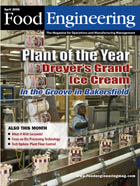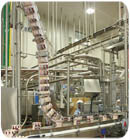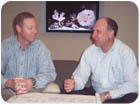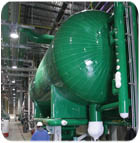
If officials at Dreyer's Grand Ice Cream Inc. and Nestlé SA wanted a symbol of their frozen snacks' merger, they couldn't do better than the expanded Dreyer's plant in Bakersfield, CA.
Since 1983, Food Engineering has celebrated outstanding examples of food and beverage facility design and construction from sea to shining sea with the annual Food Plant of the Year award. Nestlé's Carnation plant in Bakersfield was honored in 1989 ("World's largest ice-cream plant," Food Engineering, March 1989). When the process of unifying the Nestlé and Dreyer's businesses began in 2003, Dreyer's management recognized the need to consolidate California operations, driving a major expansion at one of the remaining plants. "We considered several sites that initially did not include Bakersfield," recalls Doug Bame, Dreyer's capital engineering manager. "Then we decided, ‘Let's not leave any stone unturned,' and came to look at Bakersfield."
What they found was a 250,000-sq.-ft. ice cream novelties plant on a 47-acre site in a former farming region that has morphed into southern California's fastest growing bedroom community. Los Angeles is two hours away, and affordable housing drew 60,000 new souls since 2000, boosting Bakersfield to No. 60 on America's urban Top 100 list. More importantly, the Bakersfield site had 20 open acres and the infrastructure to accommodate a tripling of plant capacity. The project team realized almost immediately they were standing on the future site of the future center of North American ice cream culture, Nestlé/Dreyer's style.

Formed cartons feed down a wire-guided conveyor to a filling machine in the new production area at Dreyer's Grand Ice Cream's Bakersfield, CA, plant. Photo by Alexander Horvath.
Dreyer's had not built a new plant since the late 1980s. The Bakersfield project gave Dreyer's manufacturing team its first blank canvass to implement design improvements and processing systems in a 332,000 sq. ft., $100 million project. It also was an opportunity to complete the cultural transition to the Dreyer's way in Bakersfield.
"Dreyer's has a unique culture, which is reflected in the 10 grooves of (Chairman) Gary Rogers and (former President) Rick Cronk," explains Bame. "The grooves outline how you conduct yourself with others and what the company is committed to. One principle is to act if you have the majority of the information you need, because we're not afraid to try new things." (See related story on page 60.)

Dreyer's Doug Bame (left) and Karl Landgraf of The Dennis Group review engineering specifications for the Bakersfield facility. Landgraf was the A/E firm's project manager, while Bame serves as capital engineering manager.
Purity under control
A greater emphasis on food safety and advances in controls technology are the most dramatic changes in food production over the 17 years that separate the two plants under one roof in Bakersfield. As workers enter the plant, the new priorities and the operation's new operating philosophy are highlighted on an electronic message board that blinks, "Safety.....Quality....Grooves."Safety is reflected in building details. Though not dramatic, they are plentiful. "The deck of installation details was 50 pages thick," remembers Bame. A no-compromise approach meant coordinating mechanical, electrical and ceiling-installation workers to avoid slotting of tiles, for example. Flush-mounted metal halide lights are sealed from the bottom to prevent dust and dirt from infiltrating the processing area. "Sanitary design details are an area where we didn't compromise," he emphasizes.
The project was still on the drawing board when the US Congress was debating the Food Allergen Labeling and Consumer Protection Act, heightening sensitivity to allergen cross contamination as a food safety issue. Four of the eight major allergens-milk, eggs, peanuts and tree nuts-are common ingredients in ice cream production, and adopting strict sanitation procedures and controls is critical if manufacturers are to avoid label declarations that discourage millions of consumers from buying their products. In Bakersfield, Dreyer's has taken the lead in allergen control.
Huhtamaki packaging machines form the 56-oz. cartons of Dreyer's Grand Ice Cream produced in the new 119,000-sq.-ft. production area, feeding them down cable-guided conveyors from a mezzanine above the production floor (air conveyors were rejected because of the sanitation procedures that they often require). The potential exists for a carton of a nonallergenic product to be mixed with flats for ice cream containing, for example, eggs. To eliminate the hazard, Dreyer's engineers worked with the machine supplier to develop sensors that read a code adjacent to bar codes on each flat and kick out any incorrect cartons before they are formed.
High-shear mixers for melting product for rework featured a troublesome seal. At Dreyer's urging, the manufacturer, Breddo Likwifier, reengineered the component for flush mounting. "We've always believed in loyalty and a two-way relationship with key suppliers," says Bame. "We get good-quality equipment and help them take their equipment to a higher level."
The most visible symbols of the allergen-control program are the clusters of mix-proof valves to regulate CIP cycles and product flow through a dozen pasteurized mix tanks. The tanks are grouped in fours, with 34 mix-proof valves regulating flow through each group "for ultimate protection" against any nicked valve seats and other unseen harborage points, Bame says.
Sequencing product and CIP flow patterns through those valves was the responsibility of The Dennis Group's Steve Guericke, who also designed the integrated controls network. Whereas production lines in the plant's older section draw mix from a central location, "each line is its own work center" in the new area, Guericke says. "They know when every tank was cleaned, inspected and signed off on, they know which mix tanks have the oldest inventory, and they know what is going on in all the other lines." Programming work stretched over six months and involved custom codes written in house and proprietary programming developed for Dreyer's by Carlson Engineering.
The controls architecture extends to the three 25-ft.-diameter spiral freezers where ice cream is hardened. Variable frequency drives adjust residence time depending on product load. Product temperatures are reduced to 0

R&D Director Don Birnbaum inspects an ice cream freezer in a small-scale pilot line. As development projects move closer to production, work shifts to a larger line with throughput capacity 20 times greater. Photo by Alexander Horvath.
Utilities wish list
While the original facility was hailed for its sanitary design, the demand for food safety is magnitudes greater today. "The existing side of the plant needed better air," notes Karl Landgraf, project manager and a principal with The Dennis Group. His firm won the architectural design and engineering contract at Bakersfield after a rigorous A/E review process. Dennis Group also is directing a 600,000-sq.-ft. expansion at Dreyer's Laurel, MD, facility, slated for completion this spring.Instead of using rotary or piston compressors for the compressed air system, Landgraf opted for large centrifugal compressors, each capable of generating more than 1,500 cubic feet of filtered air a minute. Centrifugal compressors are common in petrochemical plants, says Landgraf, and are much more energy efficient. The units also require less space than the half-dozen rotary compressors that would have been needed, and the capital cost is less.
In ice cream production, air is an ingredient, Bame points out, and most plants rely on dedicated air-purification units for each ice cream freezer. With 15 freezers, Bakersfield's 85 maintenance workers would have faced a big challenge. Instead, air from the compressors is siphoned through a series of cartridge filters to deliver sterile air for overrun. A desiccant unit must be maintained, Landgraf allows, but the tradeoff beats the alternative.

A mechanic inspects ice cream cartons as they emerge from a shrink-wrap bundling machine. From here, product descends to a palletizing area. Photo by Alexander Horvath.
Dreyer's-Bakersfield sits in uneasy proximity to the San Andreas Fault. Earthquake protection was part of the facility's original design, and the same considerations are reflected in the expansion. Disaster-control helped drive the installation of a flow-down refrigeration system, a design that reduces the quantity of ammonia stored on site and offers built-in safeguards against accidental ammonia release. Instead of storing liquid ammonia at 125-160 psi, Bakersfield's flow-down system stores 73,000 lbs. in a slight vacuum in a massive tank capable of holding up to 103,000 lbs. The tank's -35

A 103,000-lb. capacity anhydrous ammonia storage tank stores liquid ammonia in Bakersfield's flow-down refrigeration system. Photo by Alexander Horvath.
Leading-edge processes
In adding a second processing room, engineers extended a service corridor in the existing plant an additional 300 feet, modifying tilt-up panels installed in 1988 to create a unified processing area. While ice cream novelties are manufactured in the older section, 56-oz. cartons are the focus in the new area. Designed for five high-volume carton lines, the room also hosts a line producing Dreyer's popular Dibs® novelties, and a seventh production line soon will be installed. Throughput is projected to be 90 million gallons a year.Several lines produce the company's Slow Churned® ice cream, a product with a creamy texture despite its lower fat content. Dreyer's food scientists began work on the process, generically referred to as low temperature freezing, a decade ago, says Don Birnbaum, the company's R&D director. "Others have approached texture from an ingredient angle; this is truly a process innovation," he says.
Whether it is shear, pressure or some other variable, the same mouthfeel change has been noted with fluid milk subjected to ultrafiltration. Adding cream as an ingredient with low temperature freezing would be overkill. "Using normal levels of milkfat would be like putting a stick of butter on a piece of toast," says Mark McLenithan, plant manager and head of the Dreyer's team on the expansion project. "It's too much."

Dreyer's employee Jim Lontz inspects an ice cream carton on a kickoff table. Photo by Alexander Horvath.
The opposite mezzanine receives cartons as they exit hardening spirals. After being case-packed or bundled and shrink-wrapped, cartons descend to a palletizing area. The temperature gradient between these two areas is approximately 40

A sea of control tops on mix-proof valves attests to the serious approach to fail-safe programming to ensure allergens are removed in CIP cycles between production runs in Bakersfield. Photo by Alexander Horvath.
Fully staffed, Bakersfield will employ 1,100 operators, maintenance workers, food scientists and other professionals, McLenithan estimates. "This plant is designed to be our innovation engine for the next several decades," he says. If the R&D team designs a product, "whether it's extruded, molded, you name it, we can make it." It's simply a matter of finding the right groove.
"The grooves are how we leverage each person to make a positive difference," McLenithan explains. "It's about staying within parameters and not putting people and products at risk." In order to foster the mantra of "One Plant, One Culture," all team members will have to embrace the grooves philosophy. While Landgraf and his engineering team were erecting physical walls, McLenithan and his colleagues were building organizational bridges between those workers. "We're probably more in line with the original operating principles than the plant has been in a long time," he assures.
When Dreyer's $180 million Laurel expansion is complete, Bakersfield will be edged out as the company's largest ice cream plant. But sheer size isn't the measure of an outstanding food-production facility, and it is the sum of the food safety upgrades, infrastructure improvements and production innovations that distinguish Bakersfield as Food Engineering's 2006 Food Plant of the Year.
For more information:
Karl Landgraf, The Dennis Group, 858-847-9633,landgraf@dennisgrp.com
Charles R. Taylor, The Stellar Group, 904-899-9401,ctaylor@thestellargroup.com
Sidebar1: New Age industrial engineering
Self-directed work teams are an industrial engineering concept to achieve continuous improvement, and dozens of present day workers at Dreyer's Bakersfield plant were indoctrinated in the work-team concept when the plant opened in 1988 as a Carnation facility. Those same workers now are being indoctrinated in the Grooves, 10 organizational principles of the Dreyer's corporate culture.The Grooves cover more ground than continuous improvement, though that is certainly part of the underlying message. The 10 principles are:
- Respect for the individual
- Management is people
- Hire smart
- Ownership
- Learn, learn, learn
- Upside down organization
- People involvement
- Ready, fire, aim
- Hoopla
- Face-to-face communication.

Sidebar 2: This Dibs for you
When T. Gary Rogers and William Cronk III were dueling Unilever for leadership of America's ice cream business in the 1990s, their goal was to do in frozen treats what Anheuser-Busch did in beer. Dreyer's Grand Ice Cream now is under the Nestlé umbrella, and the one-time University of California-Berkeley classmates hope the new company can elevate Dreyer's from playing Miller to Unilever's Bud.Rogers and Cronk acquired Oakland, CA-based Dreyer's in 1977 and presided over a growth trajectory that took them from $6 million to $792 million in 20 years. Along the way they built a direct store delivery system that enabled Dreyer's to achieve national distribution (products are sold under the Edy's brand East of the Rockies). Marketing also was a priority: after selling a minority stake to Nestlé for $106 million in 1994, Dreyer's plowed $50 million in trade discounts and $50 million for consumer ads and promotions the following year-a remarkable investment, given that total industry ad spending for ice cream at the time was pegged at $26 million.
Rogers and Cronk also prided themselves in product innovation, and the latest Dreyer's breakthrough is Dibs® snacks, bite-size ice cream morsels enrobed in chocolate and cryogenically frozen. The line rang up supermarket sales of almost $40 million in its first six months, according to Information Resources Inc. "The next little thing in ice cream" is the tagline for a $25 million ad campaign being launched for Dibs this month, reports Brandweek. Until those ads bear fruit, Dibs and Dreyer's will have to settle for being less filling, tastes great: 2005's total sales were $1.7 billion, trailing Unilever's combined Ben & Jerry's and Good Humor Breyers gross by approximately $400 million.



